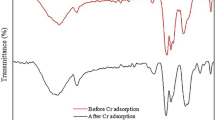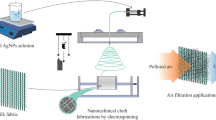Abstract
Membranes play a vital role in membrane-based water treatment processes. Thus, improvement in the membrane fabrication stage can greatly affect the overall performance of these technologies. Accordingly, this study focuses on optimizing the fabrication process of a microfiltration cellulose acetate membrane prepared using a pore-templating method. The effects of synthesis variables and their interactions were investigated using face-centered composite design through response surface methodology (RSM). Calcium carbonate (CaCO3) and glycerin concentrations in the casting solution in addition to evaporation time and hydrochloric acid (HCl) bath time were selected as the independent variables, while the membrane porosity and pure water flux were considered as the response variables. Significant increase in both responses was observed by increasing CaCO3 and glycerin concentrations (P value < 0.05). However, the effect of evaporation time was found to be statistically insignificant on both responses. The effect of the HCl bath time was found to significantly affect the membrane porosity but not the pure water flux. RSM models for both responses were statistically evaluated in terms of the coefficient of determination (R2), and the estimated values (96.74% for the porosity model and 83.85% for the flux model) indicated good fit of the model to the experimental values. Multiple response optimization was employed, and the membrane produced at optimum conditions proved to have good agreement with the predicted values (16.2% error in flux and 3.66% error in porosity). The membrane was successfully applied for paint pigment rejection and oil emulsion rejection, and rejection efficiencies of 95.6% and 80% were achieved for color and oil, respectively, confirming the applicability of the membrane produced at the obtained optimum condition for wastewater treatment.












Similar content being viewed by others
References
Anis, S.F.; Hashaikeh, R.; Hilal, N.: Microfiltration membrane processes: a review of research trends over the past decade. J. Water Process Eng. (2019). https://doi.org/10.1016/j.jwpe.2019.100941
Kulozik, U.: Chapter 1—Ultra- and microfiltration in dairy technology. In: Basile, A.; Ghasemzadeh, K. (eds.). Current Trends and Future Developments on (Bio-) Membranes. Membrane Processes in the Pharmaceutical and Biotechnological Field, pp. 1–28. Elsevier (2019). https://doi.org/10.1016/B978-0-12-813606-5.00001-4
Davis, R.H.: Chapter 2—Microfiltration in pharmaceutics and biotechnology. Basile, A.; Ghasemzadeh, K. (eds.). Current Trends and Future Developments on (Bio-) Membranes. Membrane Processes in the Pharmaceutical and Biotechnological Field, pp. 29–67. Elsevier (2019). https://doi.org/10.1016/B978-0-12-813606-5.00002-6
Achiou, B.; et al.: Manufacturing of tubular ceramic microfiltration membrane based on natural pozzolan for pretreatment of seawater desalination. Desalination 419, 181–187 (2017). https://doi.org/10.1016/j.desal.2017.06.014
Dang, H.T.T.; Tran, H.D.; Tran, S.H.; Sasakawa, M.; Narbaitz, R.M.: Treatment and reuse of coalmine wastewater in Vietnam: application of microfiltration. Water Qual. Res. J. Can. 53(3), 133–142 (2018). https://doi.org/10.2166/wqrj.2018.028
Mouiya, M.; et al.: Fabrication and characterization of a ceramic membrane from clay and banana peel powder: application to industrial wastewater treatment. Mater. Chem. Phys. 227, 291–301 (2019). https://doi.org/10.1016/j.matchemphys.2019.02.011
Rasouli, Y.; Abbasi, M.; Hashemifard, S.A.: Fabrication, characterization, fouling behavior and performance study of ceramic microfiltration membranes for oily wastewater treatment. J. Asian Ceram. Soc. 7(4), 476–495 (2019). https://doi.org/10.1080/21870764.2019.1667070
Saini, P.; Bulasara, V.K.; Reddy, A.S.: Performance of a new ceramic microfiltration membrane based on kaolin in textile industry wastewater treatment. Chem. Eng. Commun. 206(2), 227–236 (2019). https://doi.org/10.1080/00986445.2018.1482281
Cui, Z.; et al.: Fabricating PVDF hollow fiber microfiltration membrane with a tenon-connection structure via the thermally induced phase separation process to enhance strength and permeability. Eur. Polym. J. 111, 49–62 (2019). https://doi.org/10.1016/j.eurpolymj.2018.12.009
Mansoori, S.; Davarnejad, R.; Matsuura, T.; Ismail, A.F.: Membranes based on non-synthetic (natural) polymers for wastewater treatment. Polym. Test. (2020). https://doi.org/10.1016/j.polymertesting.2020.106381
Peng, B.; Yao, Z.; Wang, X.; Crombeen, M.; Sweeney, D.G.; Tam, K.C.: Cellulose-based materials in wastewater treatment of petroleum industry. Green Energy Environ. 5(1), 37–49 (2020). https://doi.org/10.1016/j.gee.2019.09.003
Saljoughi, E.; Mohammadi, T.: Cellulose acetate (CA)/polyvinylpyrrolidone (PVP) blend asymmetric membranes: preparation, morphology and performance. Desalination 249(2), 850–854 (2009). https://doi.org/10.1016/j.desal.2008.12.066
Saljoughi, E.; Sadrzadeh, M.; Mohammadi, T.: Effect of preparation variables on morphology and pure water permeation flux through asymmetric cellulose acetate membranes. J. Membr. Sci. 326(2), 627–634 (2009). https://doi.org/10.1016/j.memsci.2008.10.044
Kusworo, T.D.; Hadiyanto, H.; Deariska, D.; Nugraha, L.: Enhancement of separation performance of asymmetric cellulose acetate membrane for produced water treatment using response surface methodology. Chem. Ind. Chem. Eng. Q. 24(2), 139–147 (2018). https://doi.org/10.2298/CICEQ170112026K
Su Shen, S.; Chen, H.; Hua Wang, R.; Ji, W.; Zhang, Y.; Bai, R.: Preparation of antifouling cellulose acetate membranes with good hydrophilic and oleophobic surface properties. Mater. Lett. 252, 1–4 (2019). https://doi.org/10.1016/j.matlet.2019.03.089
Hu, M.-X.; Niu, H.-M.; Chen, X.-L.; Zhan, H.-B.: Natural cellulose microfiltration membranes for oil/water nanoemulsions separation. Colloids Surf. A Physicochem. Eng. Asp. 564, 142–151 (2019). https://doi.org/10.1016/j.colsurfa.2018.12.045
Mu, C.; Su, Y.; Sun, M.; Chen, W.; Jiang, Z.: Remarkable improvement of the performance of poly(vinylidene fluoride) microfiltration membranes by the additive of cellulose acetate. J. Membr. Sci. 350(1–2), 293–300 (2010). https://doi.org/10.1016/j.memsci.2010.01.004
Kellenberger, C.R.; Luechinger, N.A.; Lamprou, A.; Rossier, M.; Grass, R.N.; Stark, W.J.: Soluble nanoparticles as removable pore templates for the preparation of polymer ultrafiltration membranes. J. Membr. Sci. 387–388, 76–82 (2012). https://doi.org/10.1016/j.memsci.2011.10.011
Kaiser, A.; Stark, W.J.; Grass, R.N.: Rapid production of a porous cellulose acetate membrane for water filtration using readily available chemicals. J. Chem. Educ. 94(4), 483–487 (2017). https://doi.org/10.1021/acs.jchemed.6b00776
Wagner, J.R.; Mount, E.M.; Giles, H.F.: 25—Design of experiments. In: Wagner, J.R., Mount, E.M., H. F. B. T.-E. (Second E. Giles (eds.) Plastics Design Library, pp. 291–308. William Andrew Publishing, Oxford (2014)
Baneshi, M.M.; et al.: A high-flux P84 polyimide mixed matrix membranes incorporated with cadmium-based metal organic frameworks for enhanced simultaneous dyes removal: response surface methodology. Environ. Res. (2020). https://doi.org/10.1016/j.envres.2020.109278
Díaz-Cruz, J.M.; Esteban, M.; Ariño, C.: Experimental design and optimization. In: Chemometrics in Electroanalysis. Monographs in Electrochemistry. Springer, Cham. (2019). https://doi.org/10.1007/978-3-030-21384-8_4
Vasanth, D.; Pugazhenthi, G.; Uppaluri, R.: Performance of low cost ceramic microfiltration membranes for the treatment of oil-in-water emulsions. Sep. Sci. Technol. 48(6), 849–858 (2013). https://doi.org/10.1080/01496395.2012.712598
Kuang, W.; et al.: Investigation of internal concentration polarization reduction in forward osmosis membrane using nano-CaCO3 particles as sacrificial component. J. Membr. Sci. 497, 485–493 (2016). https://doi.org/10.1016/j.memsci.2015.06.052
Suthabanditpong, W.; Takai, C.; Razavi-Khosroshahi, H.; Okada, Y.; El-Salmawy, M.S.; Fuji, M.: Influence of CaCO3 pore-forming agent on porosity and thermal conductivity of cellulose acetate materials prepared by non-solvent induced phase separation. Adv. Powder Technol. 30(1), 207–213 (2019). https://doi.org/10.1016/j.apt.2018.10.024
Hess, S.C.; Kohll, A.X.; Raso, R.A.; Schumacher, C.M.; Grass, R.N.; Stark, W.J.: Template-particle stabilized bicontinuous emulsion yielding controlled assembly of hierarchical high-flux filtration membranes. ACS Appl. Mater. Interfaces 7(1), 611–617 (2015). https://doi.org/10.1021/am506737n
Feng, C.; Wang, R.; Shi, B.; Li, G.; Wu, Y.: Factors affecting pore structure and performance of poly(vinylidene fluoride-co-hexafluoro propylene) asymmetric porous membrane. J. Membr. Sci. 277(1–2), 55–64 (2006). https://doi.org/10.1016/j.memsci.2005.10.009
Jami’An, W.N.R.; Hasbullah, H.; Mohamed, F.; Yusof, N.; Ibrahim, N.; Ali, R.R.: Effect of evaporation time on cellulose acetate membrane for gas separation. IOP Conf. Ser. Earth Environ. Sci. (2016). https://doi.org/10.1088/1755-1315/36/1/012008
Gebru, K.A.; Das, C.: Removal of bovine serum albumin from wastewater using fouling resistant ultrafiltration membranes based on the blends of cellulose acetate, and PVP-TiO2 nanoparticles. J. Environ. Manag. 200, 283–294 (2017). https://doi.org/10.1016/j.jenvman.2017.05.086
He, X.: Fabrication of defect-free cellulose acetate hollow fibers by optimization of spinning parameters. Membranes (Basel) 7(2), 1–9 (2017). https://doi.org/10.3390/membranes7020027
Sudiarti, T.; Wahyuningrum, D.; Bundjali, B.; Made Arcana, I.: Mechanical strength and ionic conductivity of polymer electrolyte membranes prepared from cellulose acetate-lithium perchlorate. IOP Conf. Ser. Mater. Sci. Eng. (2017). https://doi.org/10.1088/1757-899x/223/1/012052
Gorassini, A.; Adami, G.; Calvini, P.; Giacomello, A.: ATR-FTIR characterization of old pressure sensitive adhesive tapes in historic papers. J. Cult. Herit. 21, 775–785 (2016). https://doi.org/10.1016/j.culher.2016.03.005
Rajeswari, A.; Jackcina-Stobel-Christy, E.; Ida Celine Mary, G.; Jayaraj, K.; Pius, A.: Cellulose acetate based biopolymeric mixed matrix membranes with various nanoparticles for environmental remediation-A comparative study. J. Environ. Chem. Eng. (2019). https://doi.org/10.1016/j.jece.2019.103278
Almojjly, A.; Johnson, D.; Hilal, N.: Investigations of the effect of pore size of ceramic membranes on the pilot-scale removal of oil from oil-water emulsion. J. Water Process Eng. (2019). https://doi.org/10.1016/j.jwpe.2019.100868
Author information
Authors and Affiliations
Corresponding author
Ethics declarations
Conflict of interest
The authors confirm that they have no conflict of interest to declare for this publication.
Rights and permissions
About this article
Cite this article
Mohammed Redha, Z., Bu-Ali, Q., Saeed, Y.A. et al. Optimization of the Asymmetric Cellulose Acetate Membrane Synthesis Variables for Porosity and Pure Water Permeation Flux Using Response Surface Methodology: Microfiltration Application. Arab J Sci Eng 46, 6593–6607 (2021). https://doi.org/10.1007/s13369-020-05298-5
Received:
Accepted:
Published:
Issue Date:
DOI: https://doi.org/10.1007/s13369-020-05298-5




